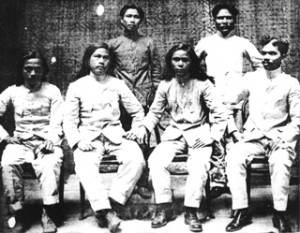
Macario Sakay: Tulisán or Patriot? by Paul Flores © 1996 by Paul Flores and PHGLA All rights reserved Contrary to popular belief, Philippine resistance to American rule did not end with the capture of Emilio Aguinaldo in 1901. There were numerous resistance forces fighting for Philippine independence until the year 1910. One of these forces was led by Macario Sakay who established the Tagalog Republic. Born in 1870 in Tondo, Macario Sakay had a working-class background. He started out as an apprentice in a calesa manufacturing shop. He was also a tailor, a barber, and an actor in comedias and moro-moros. His participation in Tagalog dramas exposed him to the world of love, courage, and discipline. In 1894, Sakay joined the Dapitan, Manila branch of the Katipunan. Due to his exemplary work, he became head of the branch. His nightly activities as an actor in comedias camouflaged his involvement with the Katipunan. Sakay assisted in the operation of the Katipunan press. During the early days of the Katipunan, Sakay worked with Andres Bonifacio and Emilio Jacinto. He fought side by side with Bonifacio in the hills of Morong (now Rizal) Province. During the initial stages of the Filipino-American war, Sakay was jailed for his seditious activities. He had been caught forming several Katipunan chapters and preaching its ideals from town to town. Republika ng Katagalugan Released in 1902 as the result of an amnesty, Sakay established with a group of other Katipuneros the Republika ng Katagalugan in the mountains of Southern Luzon. Sakay held the presidency and was also called "Generalisimo." Francisco Carreon was the vice-president and handled Sakay's correspondence. Julian Montalan was the overall supervisor for military operations. Cornelio Felizardo took charge of the northern part of Cavite (Pasay-Bacoor) while Lucio de Vega controlled the rest of the province. Aniceto Oruga operated in the lake towns of Batangas. Leon Villafuerte headed Bulacan while Benito Natividad patrolled Tanauan, Batangas. In April 1904, Sakay issued a manifesto stating that the Filipinos had a fundamental right to fight for Philippine independence. The American occupiers had already made support for independence, even through words, a crime. Sakay also declared that they were true revolutionaries and had their own constitution and an established government. They also had a flag. There were several other revolutionary manifestos written by the Tagalog Republic that would tend to disprove the U.S. government's claim that they were bandits. The Tagalog Republic's constitution was largely based on the early Katipunan creed of Bonifacio. For Sakay, the new Katipunan was simply a continuation of Bonifacio's revolutionary struggle for independence. Guerilla tactics In late 1904, Sakay and his men took military offensive against the enemy. They were successful in seizing ammunition and firearms in their raids in Cavite and Batangas. Disguised in Philippine Constabulary uniforms, they captured the U.S. military garrison in Parañaque and ran away with a large amount of revolvers, carbines, and ammunition. Sakay's men often employed these uniforms to confuse the enemy. Using guerrilla warfare, Sakay would look for a chance to use a large number of his men against a small band of the enemy. They usually attacked at night when most of the enemy was looking for relaxation. Sakay severely punished and often liquidated suspected collaborators. The Tagalog Republic enjoyed the support of the Filipino masses in the areas of Morong, Laguna, Batangas, and Cavite. Lower class people and those living in barrios contributed food, money, and other supplies to the movement. The people also helped Sakay's men evade military checkpoints. They collected information on the whereabouts of the American troops and passed them on. Muchachos working for the Americans stole ammunition and guns for the use of Sakay's men. Unable to suppress the growth of the Tagalog Republic, the Philippine Constabulary and the U.S. Army started to employ "hamletting" or reconcentration in areas where Sakay received strong assistance. The towns of Taal, Tanauan, Santo Tomas, and Nasugbu in the province of Batangas were reconcentrated. This cruel but effective counter-insurgency technique proved disastrous for the Filipino masses. The forced movement and reconcentration of a large number of people caused the outbreak of diseases such as cholera and dysentery. Food was scarce in the camps, resulting in numerous deaths. Meanwhile, search and destroy missions operated relentlessly in an attempt to suppress Sakay's forces. Muslims from Jolo were brought in to fight the guerrillas. Bloodhounds from California were imported to pursue them. The writ of habeas corpus was suspended in Cavite and Batangas to strengthen counter-insurgency efforts. With support cut off, the continuous American military offensive caused the Tagalog Republic to weaken. Fall of … [Read more...]
















